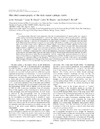Please use this identifier to cite or link to this item:
https://accedacris.ulpgc.es/jspui/handle/10553/1417
| Title: | Microbial oceanography of the dark ocean’s pelagic realm | Authors: | Aristegui, J. Gasol, Josep M. Duarte, Carlos M. Herndl, Gerhard J. |
UNESCO Clasification: | 251001 Oceanografía biológica | Keywords: | Microbiología marina Ciclo del carbono (Biogeoquímica) |
Issue Date: | 2009 | Publisher: | 0024-3590 | Project: | Expedición de Circunnavegación Malaspina 2010: Cambio Global y Exploración Del Océano Global | Journal: | Limnology and Oceanography | Abstract: | The pelagic realm of the dark ocean represents a key site for remineralization of organic matter and long-term carbon storage and burial in the biosphere. It contains the largest pool of microbes in aquatic systems, harboring nearly 75% and 50% of the prokaryotic biomass and production, respectively, of the global ocean. Genomic approaches continue to uncover the enormous and dynamic genetic variability at phylogenetic and functional\nlevels. Deep-sea prokaryotes have comparable or even higher cell-specific extracellular enzymatic activity than do microbes in surface waters, with a high fraction of freely released exoenzymes, probably indicative of a life mode reliant on surface attachment to particles or colloids. Additionally, evidence increases that chemoautotrophy might represent a significant CO2 sink and source of primary production in the dark ocean. Recent advances challenge the paradigm of stable microbial food web structure and function and slow organic-matter cycling.However, knowledge of deep-ocean food webs is still rudimentary. Dynamics of particle transformation and fate of the exported material in deep waters are still largely unknown.Discrepancies exist between estimates of carbon fluxes and remineralization rates.Recent assessments, however, suggest that integrated respiration in the dark ocean’s water column is comparable to that in the epipelagic zone, and that the dark ocean is a site of paramount importance for material cycling in the biosphere.The advent of new molecular tools and in situ sampling methodologies will improve knowledge of the dark ocean’s microbial ecosystem and resolve current discrepancies between carbon sources and metabolic requirements of deep-sea microbes. | URI: | https://accedacris.ulpgc.es/handle/10553/1417 | ISBN: | 243590 | ISSN: | 0024-3590 | DOI: | 10.4319/lo.2009.54.5.1501 | Source: | Limnology And Oceanography [ISSN 0024-3590], v. 54 (5), p. 1501-1529 |
| Appears in Collections: | Artículos |
SCOPUSTM
Citations
381
checked on Jun 8, 2025
WEB OF SCIENCETM
Citations
370
checked on Jun 8, 2025
Page view(s)
299
checked on Sep 6, 2025
Download(s)
403
checked on Sep 6, 2025
Google ScholarTM
Check
Altmetric
Share
Export metadata
Items in accedaCRIS are protected by copyright, with all rights reserved, unless otherwise indicated.
